TESCO CEO: Management Style, Leadership, and Organizational Impact
VerifiedAdded on 2022/12/29
|13
|3932
|261
Report
AI Summary
This report analyzes the leadership and management practices of TESCO's CEO, Ken Murphy. It delves into the management styles employed, including authoritarian, visionary, transactional, and democratic approaches, emphasizing the adoption of a democratic style. The report outlines the key management principles and functions, such as planning, organizing, staffing, directing, and controlling, as implemented by the CEO. It further examines the steps taken to change the organizational structure, including the application of Lewin's model (unfreezing, change, refreezing), and discusses the impact of these changes on organizational culture and employees. The report also assesses the CEO's transformational leadership style, the effects of power, influence, and conflicts within the company, and explores different types of motivation used in an organizational context. By using corporate examples and literature, the report provides recommendations and concludes with a comprehensive overview of the leadership and management strategies employed by TESCO's CEO.
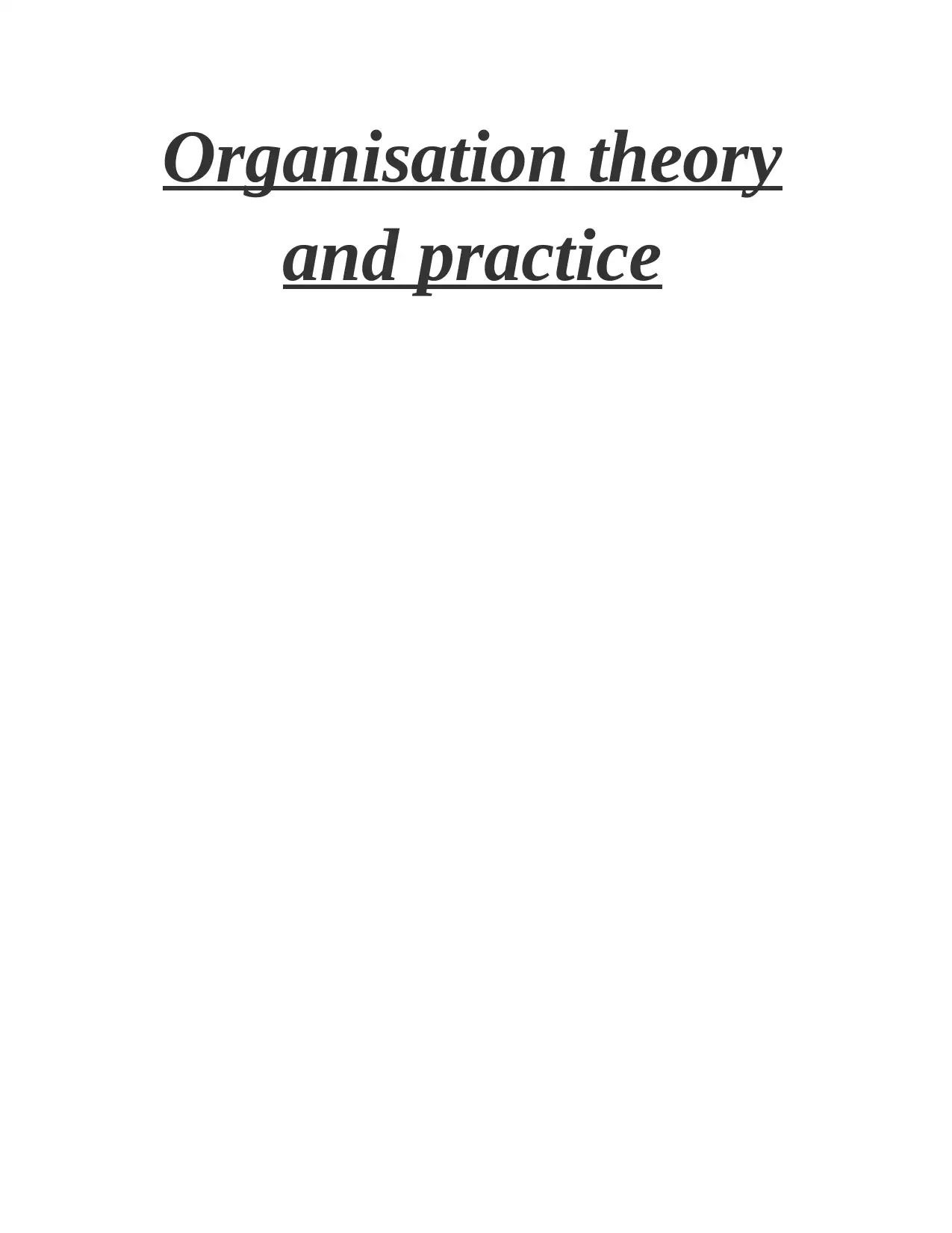
Organisation theory
and practice
and practice
Paraphrase This Document
Need a fresh take? Get an instant paraphrase of this document with our AI Paraphraser
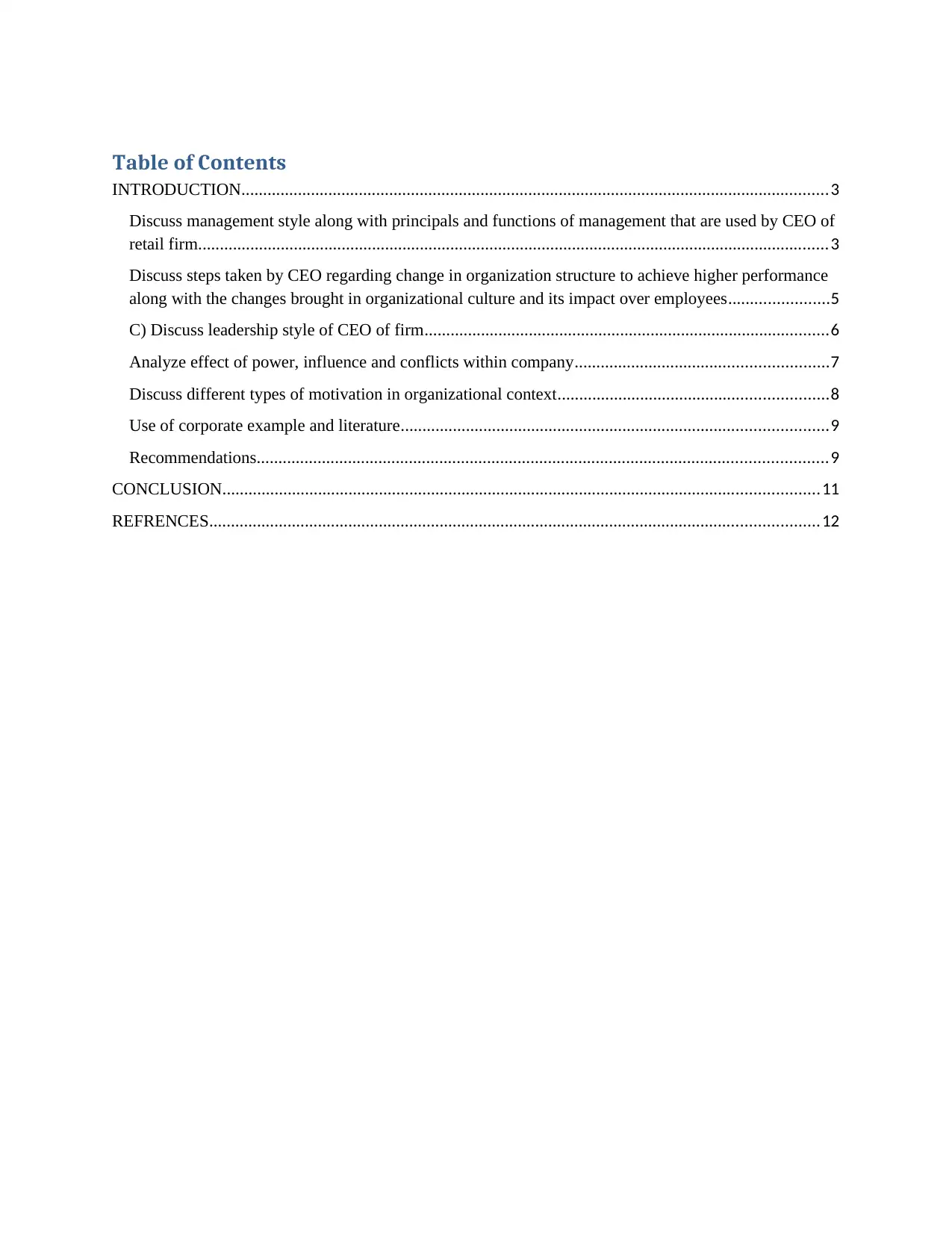
Table of Contents
INTRODUCTION.......................................................................................................................................3
Discuss management style along with principals and functions of management that are used by CEO of
retail firm.................................................................................................................................................3
Discuss steps taken by CEO regarding change in organization structure to achieve higher performance
along with the changes brought in organizational culture and its impact over employees.......................5
C) Discuss leadership style of CEO of firm.............................................................................................6
Analyze effect of power, influence and conflicts within company..........................................................7
Discuss different types of motivation in organizational context..............................................................8
Use of corporate example and literature..................................................................................................9
Recommendations...................................................................................................................................9
CONCLUSION.........................................................................................................................................11
REFRENCES............................................................................................................................................12
INTRODUCTION.......................................................................................................................................3
Discuss management style along with principals and functions of management that are used by CEO of
retail firm.................................................................................................................................................3
Discuss steps taken by CEO regarding change in organization structure to achieve higher performance
along with the changes brought in organizational culture and its impact over employees.......................5
C) Discuss leadership style of CEO of firm.............................................................................................6
Analyze effect of power, influence and conflicts within company..........................................................7
Discuss different types of motivation in organizational context..............................................................8
Use of corporate example and literature..................................................................................................9
Recommendations...................................................................................................................................9
CONCLUSION.........................................................................................................................................11
REFRENCES............................................................................................................................................12
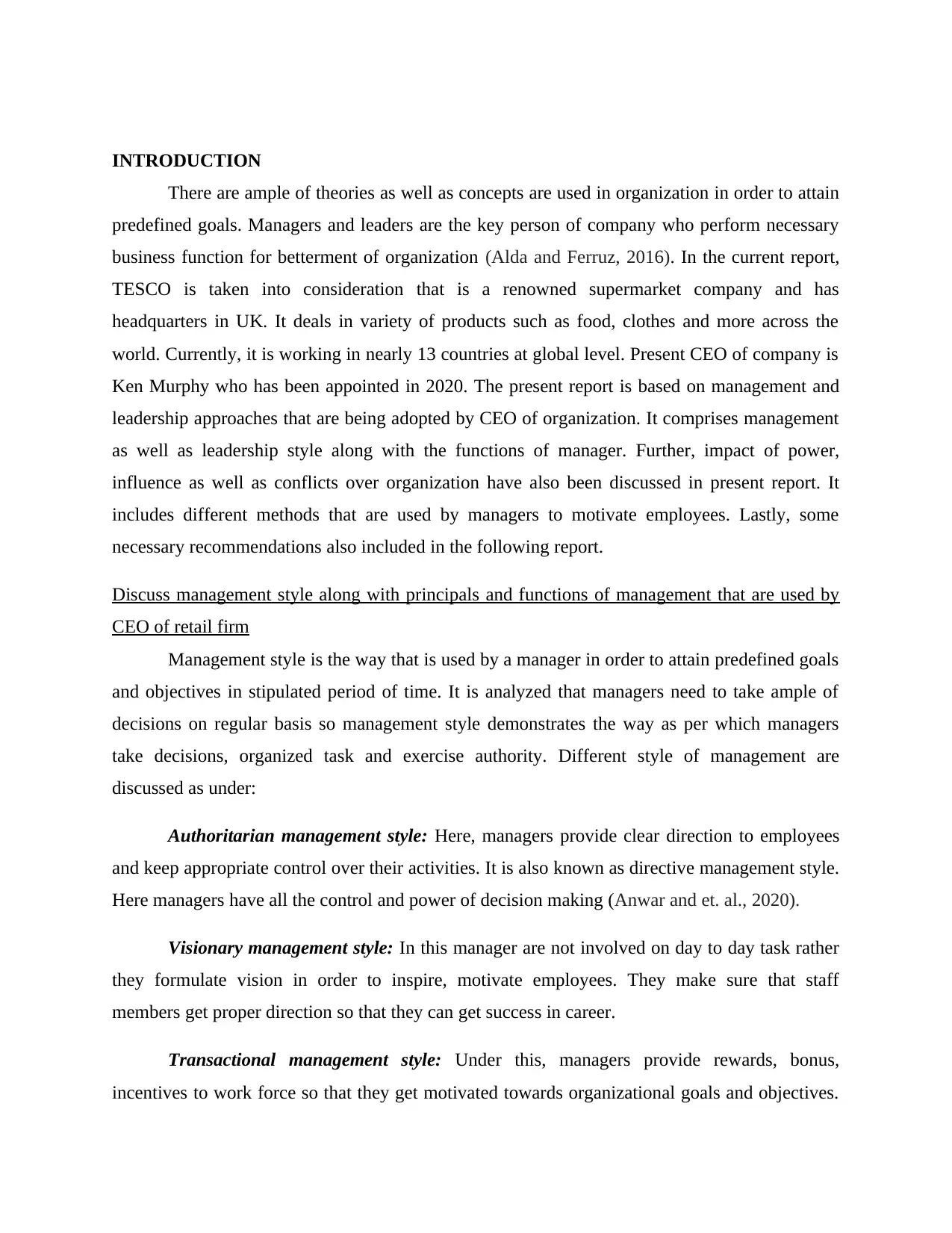
INTRODUCTION
There are ample of theories as well as concepts are used in organization in order to attain
predefined goals. Managers and leaders are the key person of company who perform necessary
business function for betterment of organization (Alda and Ferruz, 2016). In the current report,
TESCO is taken into consideration that is a renowned supermarket company and has
headquarters in UK. It deals in variety of products such as food, clothes and more across the
world. Currently, it is working in nearly 13 countries at global level. Present CEO of company is
Ken Murphy who has been appointed in 2020. The present report is based on management and
leadership approaches that are being adopted by CEO of organization. It comprises management
as well as leadership style along with the functions of manager. Further, impact of power,
influence as well as conflicts over organization have also been discussed in present report. It
includes different methods that are used by managers to motivate employees. Lastly, some
necessary recommendations also included in the following report.
Discuss management style along with principals and functions of management that are used by
CEO of retail firm
Management style is the way that is used by a manager in order to attain predefined goals
and objectives in stipulated period of time. It is analyzed that managers need to take ample of
decisions on regular basis so management style demonstrates the way as per which managers
take decisions, organized task and exercise authority. Different style of management are
discussed as under:
Authoritarian management style: Here, managers provide clear direction to employees
and keep appropriate control over their activities. It is also known as directive management style.
Here managers have all the control and power of decision making (Anwar and et. al., 2020).
Visionary management style: In this manager are not involved on day to day task rather
they formulate vision in order to inspire, motivate employees. They make sure that staff
members get proper direction so that they can get success in career.
Transactional management style: Under this, managers provide rewards, bonus,
incentives to work force so that they get motivated towards organizational goals and objectives.
There are ample of theories as well as concepts are used in organization in order to attain
predefined goals. Managers and leaders are the key person of company who perform necessary
business function for betterment of organization (Alda and Ferruz, 2016). In the current report,
TESCO is taken into consideration that is a renowned supermarket company and has
headquarters in UK. It deals in variety of products such as food, clothes and more across the
world. Currently, it is working in nearly 13 countries at global level. Present CEO of company is
Ken Murphy who has been appointed in 2020. The present report is based on management and
leadership approaches that are being adopted by CEO of organization. It comprises management
as well as leadership style along with the functions of manager. Further, impact of power,
influence as well as conflicts over organization have also been discussed in present report. It
includes different methods that are used by managers to motivate employees. Lastly, some
necessary recommendations also included in the following report.
Discuss management style along with principals and functions of management that are used by
CEO of retail firm
Management style is the way that is used by a manager in order to attain predefined goals
and objectives in stipulated period of time. It is analyzed that managers need to take ample of
decisions on regular basis so management style demonstrates the way as per which managers
take decisions, organized task and exercise authority. Different style of management are
discussed as under:
Authoritarian management style: Here, managers provide clear direction to employees
and keep appropriate control over their activities. It is also known as directive management style.
Here managers have all the control and power of decision making (Anwar and et. al., 2020).
Visionary management style: In this manager are not involved on day to day task rather
they formulate vision in order to inspire, motivate employees. They make sure that staff
members get proper direction so that they can get success in career.
Transactional management style: Under this, managers provide rewards, bonus,
incentives to work force so that they get motivated towards organizational goals and objectives.
⊘ This is a preview!⊘
Do you want full access?
Subscribe today to unlock all pages.

Trusted by 1+ million students worldwide
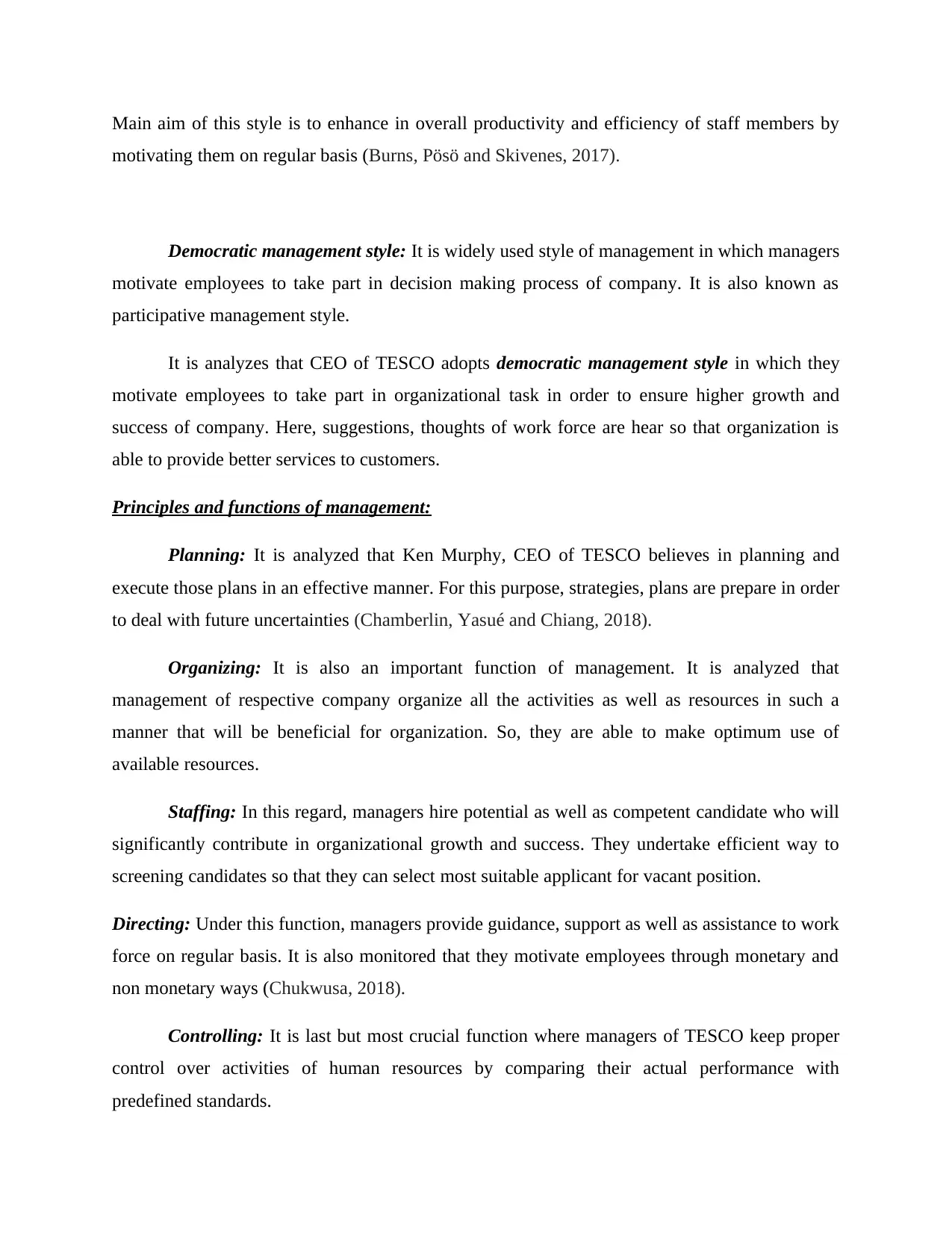
Main aim of this style is to enhance in overall productivity and efficiency of staff members by
motivating them on regular basis (Burns, Pösö and Skivenes, 2017).
Democratic management style: It is widely used style of management in which managers
motivate employees to take part in decision making process of company. It is also known as
participative management style.
It is analyzes that CEO of TESCO adopts democratic management style in which they
motivate employees to take part in organizational task in order to ensure higher growth and
success of company. Here, suggestions, thoughts of work force are hear so that organization is
able to provide better services to customers.
Principles and functions of management:
Planning: It is analyzed that Ken Murphy, CEO of TESCO believes in planning and
execute those plans in an effective manner. For this purpose, strategies, plans are prepare in order
to deal with future uncertainties (Chamberlin, Yasué and Chiang, 2018).
Organizing: It is also an important function of management. It is analyzed that
management of respective company organize all the activities as well as resources in such a
manner that will be beneficial for organization. So, they are able to make optimum use of
available resources.
Staffing: In this regard, managers hire potential as well as competent candidate who will
significantly contribute in organizational growth and success. They undertake efficient way to
screening candidates so that they can select most suitable applicant for vacant position.
Directing: Under this function, managers provide guidance, support as well as assistance to work
force on regular basis. It is also monitored that they motivate employees through monetary and
non monetary ways (Chukwusa, 2018).
Controlling: It is last but most crucial function where managers of TESCO keep proper
control over activities of human resources by comparing their actual performance with
predefined standards.
motivating them on regular basis (Burns, Pösö and Skivenes, 2017).
Democratic management style: It is widely used style of management in which managers
motivate employees to take part in decision making process of company. It is also known as
participative management style.
It is analyzes that CEO of TESCO adopts democratic management style in which they
motivate employees to take part in organizational task in order to ensure higher growth and
success of company. Here, suggestions, thoughts of work force are hear so that organization is
able to provide better services to customers.
Principles and functions of management:
Planning: It is analyzed that Ken Murphy, CEO of TESCO believes in planning and
execute those plans in an effective manner. For this purpose, strategies, plans are prepare in order
to deal with future uncertainties (Chamberlin, Yasué and Chiang, 2018).
Organizing: It is also an important function of management. It is analyzed that
management of respective company organize all the activities as well as resources in such a
manner that will be beneficial for organization. So, they are able to make optimum use of
available resources.
Staffing: In this regard, managers hire potential as well as competent candidate who will
significantly contribute in organizational growth and success. They undertake efficient way to
screening candidates so that they can select most suitable applicant for vacant position.
Directing: Under this function, managers provide guidance, support as well as assistance to work
force on regular basis. It is also monitored that they motivate employees through monetary and
non monetary ways (Chukwusa, 2018).
Controlling: It is last but most crucial function where managers of TESCO keep proper
control over activities of human resources by comparing their actual performance with
predefined standards.
Paraphrase This Document
Need a fresh take? Get an instant paraphrase of this document with our AI Paraphraser
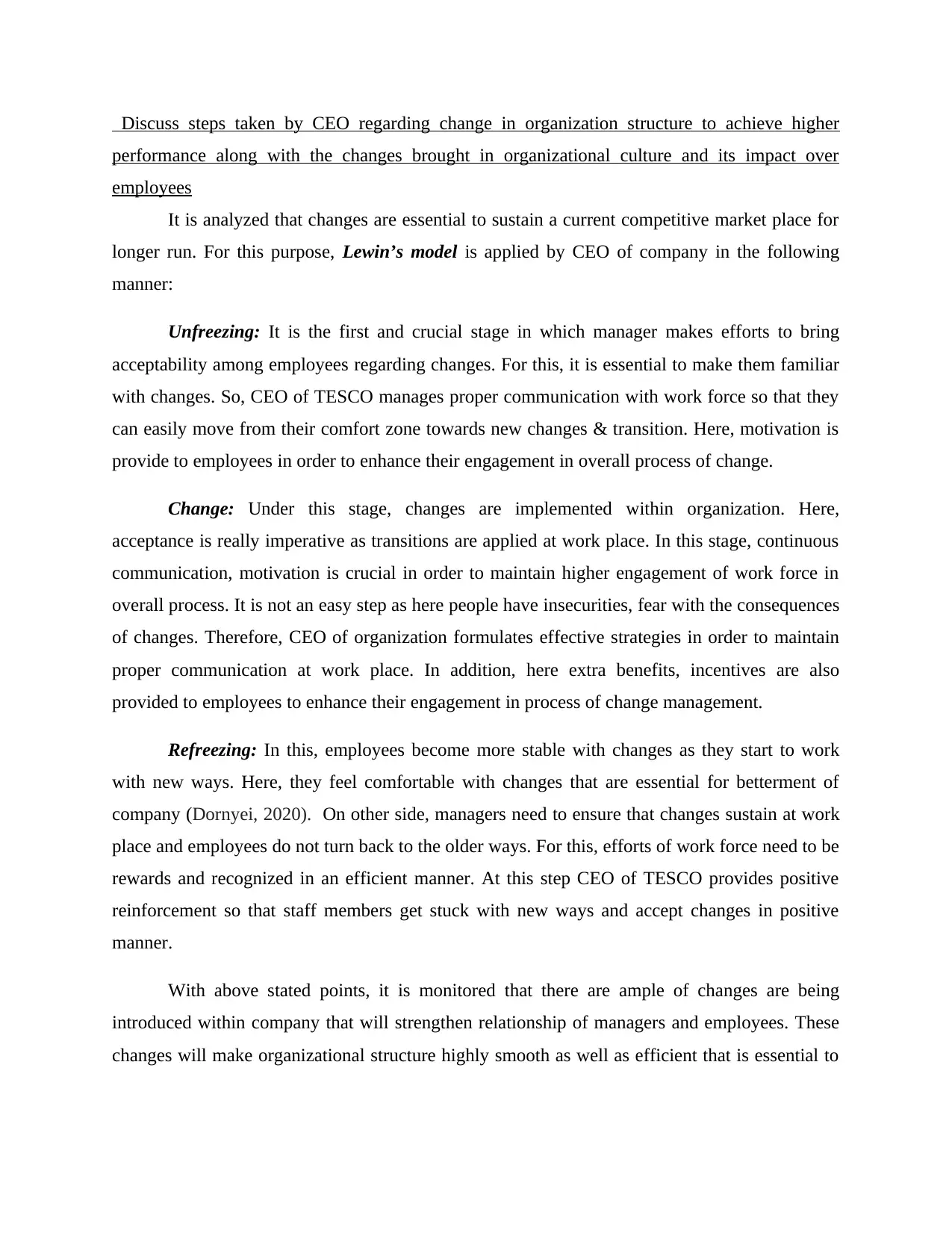
Discuss steps taken by CEO regarding change in organization structure to achieve higher
performance along with the changes brought in organizational culture and its impact over
employees
It is analyzed that changes are essential to sustain a current competitive market place for
longer run. For this purpose, Lewin’s model is applied by CEO of company in the following
manner:
Unfreezing: It is the first and crucial stage in which manager makes efforts to bring
acceptability among employees regarding changes. For this, it is essential to make them familiar
with changes. So, CEO of TESCO manages proper communication with work force so that they
can easily move from their comfort zone towards new changes & transition. Here, motivation is
provide to employees in order to enhance their engagement in overall process of change.
Change: Under this stage, changes are implemented within organization. Here,
acceptance is really imperative as transitions are applied at work place. In this stage, continuous
communication, motivation is crucial in order to maintain higher engagement of work force in
overall process. It is not an easy step as here people have insecurities, fear with the consequences
of changes. Therefore, CEO of organization formulates effective strategies in order to maintain
proper communication at work place. In addition, here extra benefits, incentives are also
provided to employees to enhance their engagement in process of change management.
Refreezing: In this, employees become more stable with changes as they start to work
with new ways. Here, they feel comfortable with changes that are essential for betterment of
company (Dornyei, 2020). On other side, managers need to ensure that changes sustain at work
place and employees do not turn back to the older ways. For this, efforts of work force need to be
rewards and recognized in an efficient manner. At this step CEO of TESCO provides positive
reinforcement so that staff members get stuck with new ways and accept changes in positive
manner.
With above stated points, it is monitored that there are ample of changes are being
introduced within company that will strengthen relationship of managers and employees. These
changes will make organizational structure highly smooth as well as efficient that is essential to
performance along with the changes brought in organizational culture and its impact over
employees
It is analyzed that changes are essential to sustain a current competitive market place for
longer run. For this purpose, Lewin’s model is applied by CEO of company in the following
manner:
Unfreezing: It is the first and crucial stage in which manager makes efforts to bring
acceptability among employees regarding changes. For this, it is essential to make them familiar
with changes. So, CEO of TESCO manages proper communication with work force so that they
can easily move from their comfort zone towards new changes & transition. Here, motivation is
provide to employees in order to enhance their engagement in overall process of change.
Change: Under this stage, changes are implemented within organization. Here,
acceptance is really imperative as transitions are applied at work place. In this stage, continuous
communication, motivation is crucial in order to maintain higher engagement of work force in
overall process. It is not an easy step as here people have insecurities, fear with the consequences
of changes. Therefore, CEO of organization formulates effective strategies in order to maintain
proper communication at work place. In addition, here extra benefits, incentives are also
provided to employees to enhance their engagement in process of change management.
Refreezing: In this, employees become more stable with changes as they start to work
with new ways. Here, they feel comfortable with changes that are essential for betterment of
company (Dornyei, 2020). On other side, managers need to ensure that changes sustain at work
place and employees do not turn back to the older ways. For this, efforts of work force need to be
rewards and recognized in an efficient manner. At this step CEO of TESCO provides positive
reinforcement so that staff members get stuck with new ways and accept changes in positive
manner.
With above stated points, it is monitored that there are ample of changes are being
introduced within company that will strengthen relationship of managers and employees. These
changes will make organizational structure highly smooth as well as efficient that is essential to
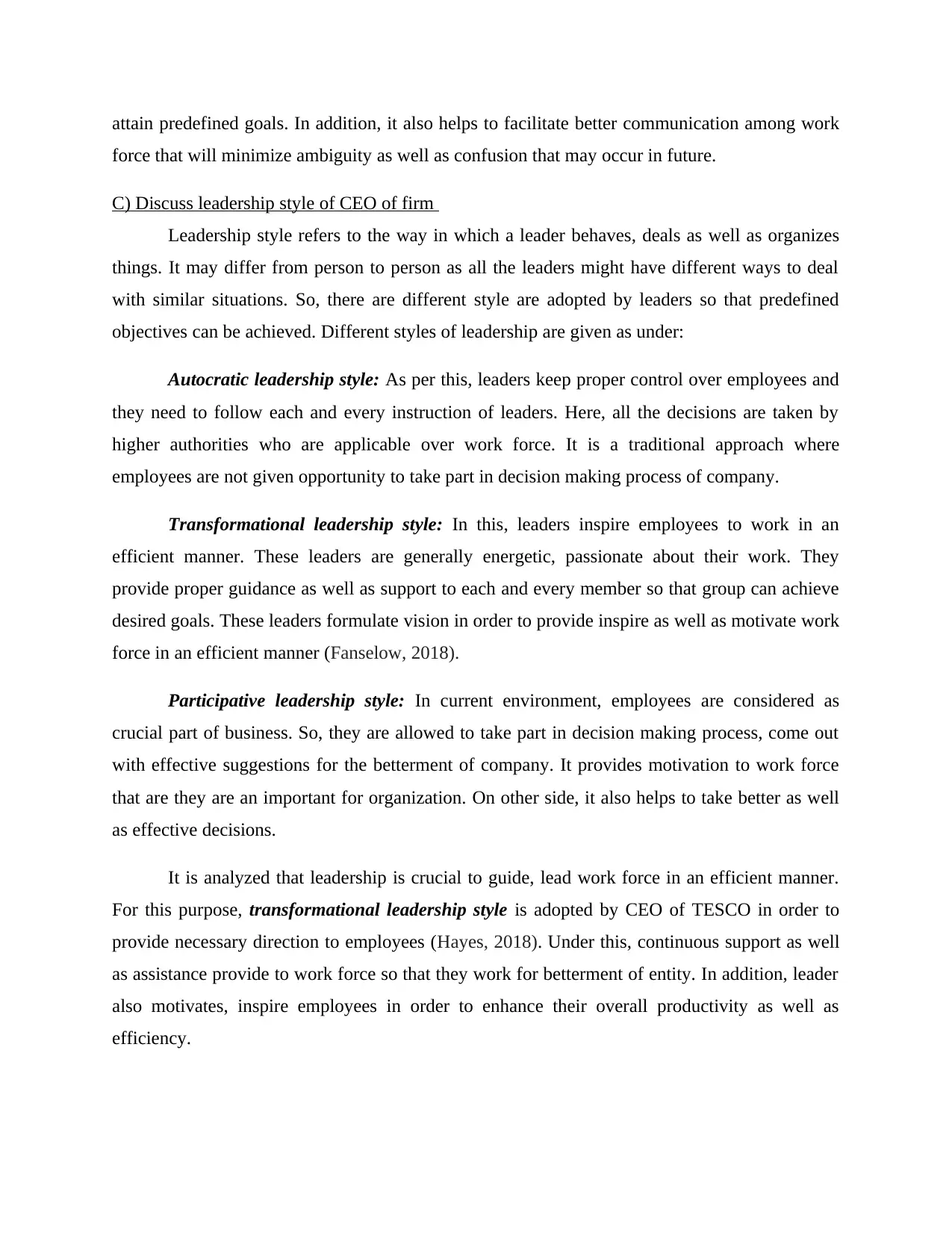
attain predefined goals. In addition, it also helps to facilitate better communication among work
force that will minimize ambiguity as well as confusion that may occur in future.
C) Discuss leadership style of CEO of firm
Leadership style refers to the way in which a leader behaves, deals as well as organizes
things. It may differ from person to person as all the leaders might have different ways to deal
with similar situations. So, there are different style are adopted by leaders so that predefined
objectives can be achieved. Different styles of leadership are given as under:
Autocratic leadership style: As per this, leaders keep proper control over employees and
they need to follow each and every instruction of leaders. Here, all the decisions are taken by
higher authorities who are applicable over work force. It is a traditional approach where
employees are not given opportunity to take part in decision making process of company.
Transformational leadership style: In this, leaders inspire employees to work in an
efficient manner. These leaders are generally energetic, passionate about their work. They
provide proper guidance as well as support to each and every member so that group can achieve
desired goals. These leaders formulate vision in order to provide inspire as well as motivate work
force in an efficient manner (Fanselow, 2018).
Participative leadership style: In current environment, employees are considered as
crucial part of business. So, they are allowed to take part in decision making process, come out
with effective suggestions for the betterment of company. It provides motivation to work force
that are they are an important for organization. On other side, it also helps to take better as well
as effective decisions.
It is analyzed that leadership is crucial to guide, lead work force in an efficient manner.
For this purpose, transformational leadership style is adopted by CEO of TESCO in order to
provide necessary direction to employees (Hayes, 2018). Under this, continuous support as well
as assistance provide to work force so that they work for betterment of entity. In addition, leader
also motivates, inspire employees in order to enhance their overall productivity as well as
efficiency.
force that will minimize ambiguity as well as confusion that may occur in future.
C) Discuss leadership style of CEO of firm
Leadership style refers to the way in which a leader behaves, deals as well as organizes
things. It may differ from person to person as all the leaders might have different ways to deal
with similar situations. So, there are different style are adopted by leaders so that predefined
objectives can be achieved. Different styles of leadership are given as under:
Autocratic leadership style: As per this, leaders keep proper control over employees and
they need to follow each and every instruction of leaders. Here, all the decisions are taken by
higher authorities who are applicable over work force. It is a traditional approach where
employees are not given opportunity to take part in decision making process of company.
Transformational leadership style: In this, leaders inspire employees to work in an
efficient manner. These leaders are generally energetic, passionate about their work. They
provide proper guidance as well as support to each and every member so that group can achieve
desired goals. These leaders formulate vision in order to provide inspire as well as motivate work
force in an efficient manner (Fanselow, 2018).
Participative leadership style: In current environment, employees are considered as
crucial part of business. So, they are allowed to take part in decision making process, come out
with effective suggestions for the betterment of company. It provides motivation to work force
that are they are an important for organization. On other side, it also helps to take better as well
as effective decisions.
It is analyzed that leadership is crucial to guide, lead work force in an efficient manner.
For this purpose, transformational leadership style is adopted by CEO of TESCO in order to
provide necessary direction to employees (Hayes, 2018). Under this, continuous support as well
as assistance provide to work force so that they work for betterment of entity. In addition, leader
also motivates, inspire employees in order to enhance their overall productivity as well as
efficiency.
⊘ This is a preview!⊘
Do you want full access?
Subscribe today to unlock all pages.

Trusted by 1+ million students worldwide
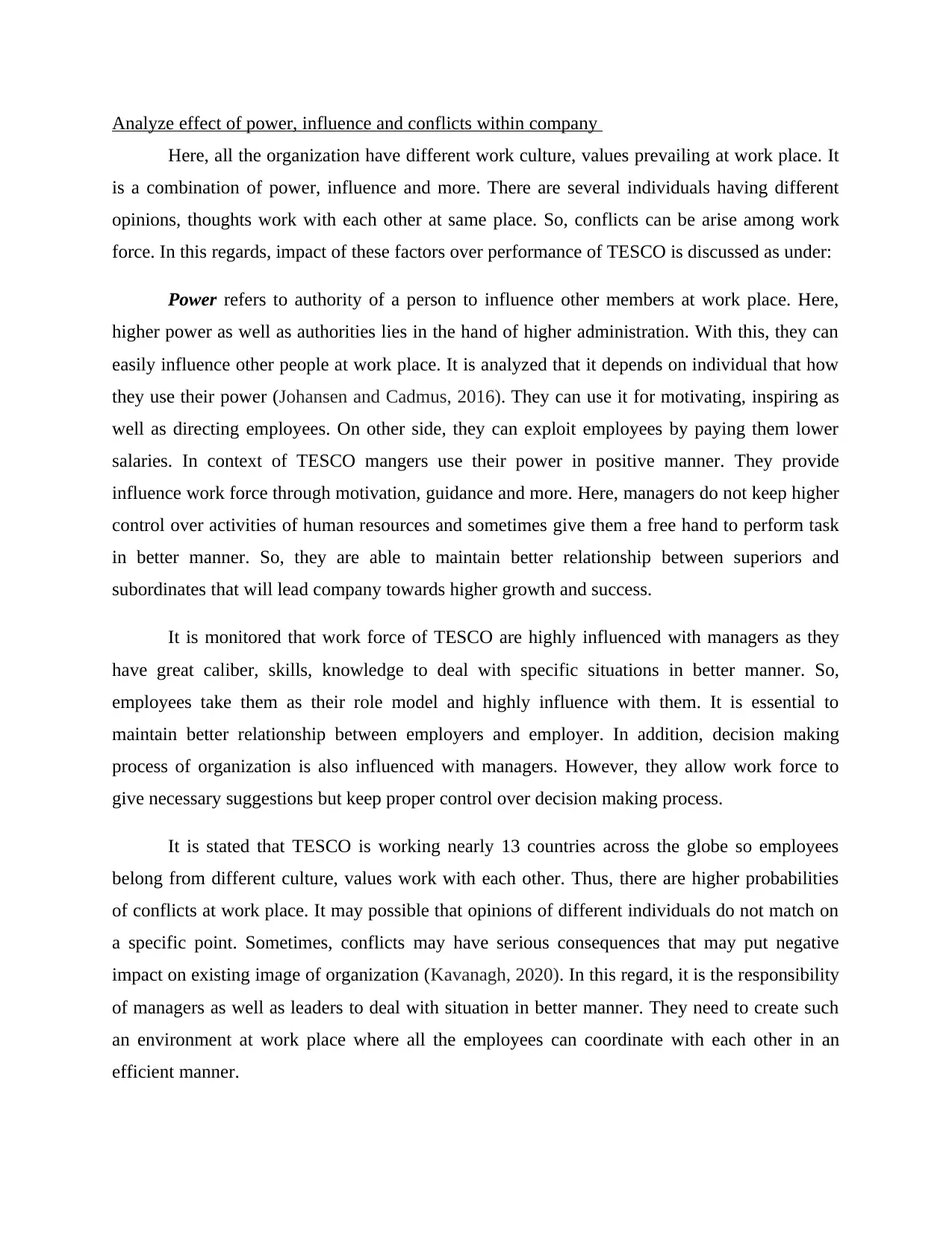
Analyze effect of power, influence and conflicts within company
Here, all the organization have different work culture, values prevailing at work place. It
is a combination of power, influence and more. There are several individuals having different
opinions, thoughts work with each other at same place. So, conflicts can be arise among work
force. In this regards, impact of these factors over performance of TESCO is discussed as under:
Power refers to authority of a person to influence other members at work place. Here,
higher power as well as authorities lies in the hand of higher administration. With this, they can
easily influence other people at work place. It is analyzed that it depends on individual that how
they use their power (Johansen and Cadmus, 2016). They can use it for motivating, inspiring as
well as directing employees. On other side, they can exploit employees by paying them lower
salaries. In context of TESCO mangers use their power in positive manner. They provide
influence work force through motivation, guidance and more. Here, managers do not keep higher
control over activities of human resources and sometimes give them a free hand to perform task
in better manner. So, they are able to maintain better relationship between superiors and
subordinates that will lead company towards higher growth and success.
It is monitored that work force of TESCO are highly influenced with managers as they
have great caliber, skills, knowledge to deal with specific situations in better manner. So,
employees take them as their role model and highly influence with them. It is essential to
maintain better relationship between employers and employer. In addition, decision making
process of organization is also influenced with managers. However, they allow work force to
give necessary suggestions but keep proper control over decision making process.
It is stated that TESCO is working nearly 13 countries across the globe so employees
belong from different culture, values work with each other. Thus, there are higher probabilities
of conflicts at work place. It may possible that opinions of different individuals do not match on
a specific point. Sometimes, conflicts may have serious consequences that may put negative
impact on existing image of organization (Kavanagh, 2020). In this regard, it is the responsibility
of managers as well as leaders to deal with situation in better manner. They need to create such
an environment at work place where all the employees can coordinate with each other in an
efficient manner.
Here, all the organization have different work culture, values prevailing at work place. It
is a combination of power, influence and more. There are several individuals having different
opinions, thoughts work with each other at same place. So, conflicts can be arise among work
force. In this regards, impact of these factors over performance of TESCO is discussed as under:
Power refers to authority of a person to influence other members at work place. Here,
higher power as well as authorities lies in the hand of higher administration. With this, they can
easily influence other people at work place. It is analyzed that it depends on individual that how
they use their power (Johansen and Cadmus, 2016). They can use it for motivating, inspiring as
well as directing employees. On other side, they can exploit employees by paying them lower
salaries. In context of TESCO mangers use their power in positive manner. They provide
influence work force through motivation, guidance and more. Here, managers do not keep higher
control over activities of human resources and sometimes give them a free hand to perform task
in better manner. So, they are able to maintain better relationship between superiors and
subordinates that will lead company towards higher growth and success.
It is monitored that work force of TESCO are highly influenced with managers as they
have great caliber, skills, knowledge to deal with specific situations in better manner. So,
employees take them as their role model and highly influence with them. It is essential to
maintain better relationship between employers and employer. In addition, decision making
process of organization is also influenced with managers. However, they allow work force to
give necessary suggestions but keep proper control over decision making process.
It is stated that TESCO is working nearly 13 countries across the globe so employees
belong from different culture, values work with each other. Thus, there are higher probabilities
of conflicts at work place. It may possible that opinions of different individuals do not match on
a specific point. Sometimes, conflicts may have serious consequences that may put negative
impact on existing image of organization (Kavanagh, 2020). In this regard, it is the responsibility
of managers as well as leaders to deal with situation in better manner. They need to create such
an environment at work place where all the employees can coordinate with each other in an
efficient manner.
Paraphrase This Document
Need a fresh take? Get an instant paraphrase of this document with our AI Paraphraser
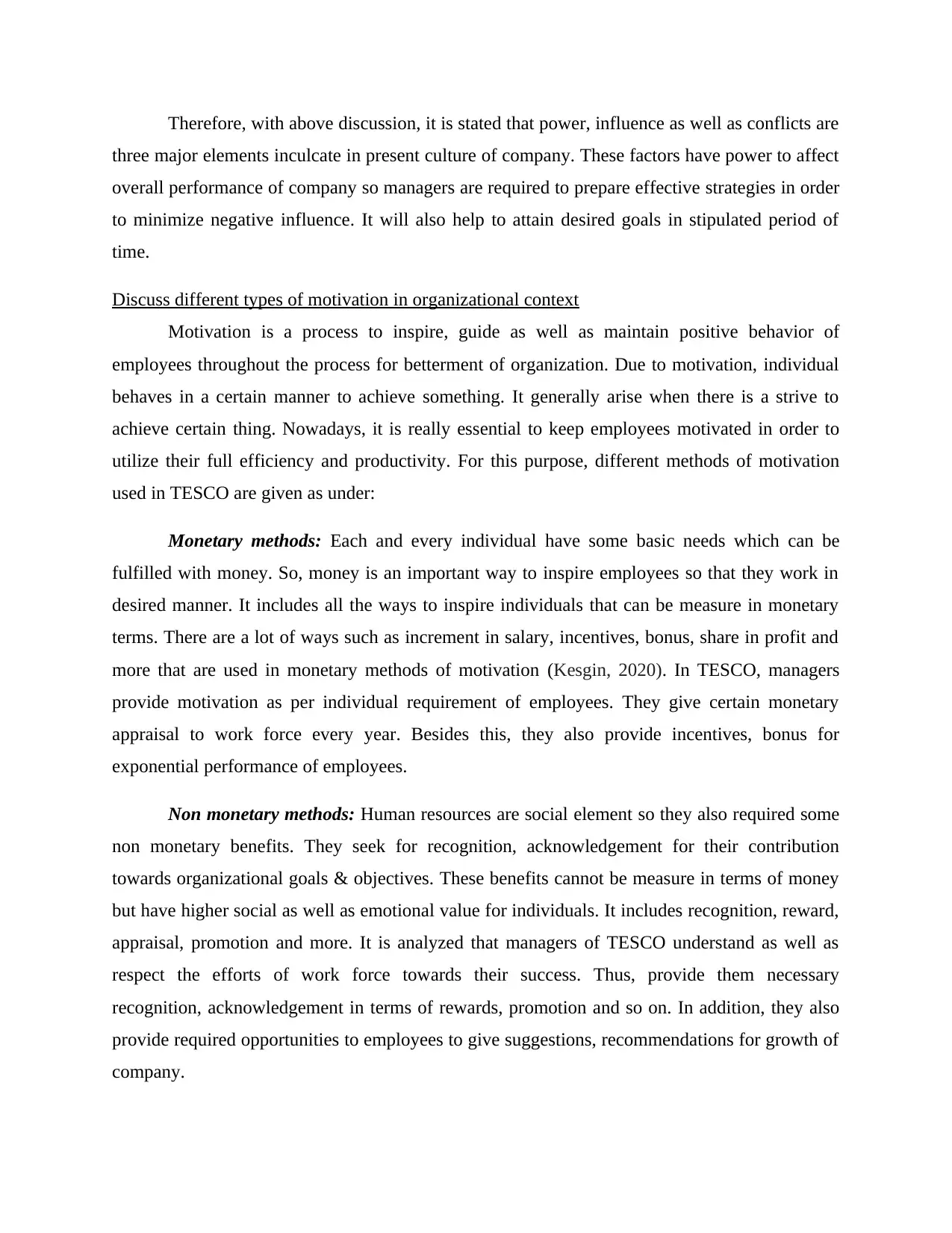
Therefore, with above discussion, it is stated that power, influence as well as conflicts are
three major elements inculcate in present culture of company. These factors have power to affect
overall performance of company so managers are required to prepare effective strategies in order
to minimize negative influence. It will also help to attain desired goals in stipulated period of
time.
Discuss different types of motivation in organizational context
Motivation is a process to inspire, guide as well as maintain positive behavior of
employees throughout the process for betterment of organization. Due to motivation, individual
behaves in a certain manner to achieve something. It generally arise when there is a strive to
achieve certain thing. Nowadays, it is really essential to keep employees motivated in order to
utilize their full efficiency and productivity. For this purpose, different methods of motivation
used in TESCO are given as under:
Monetary methods: Each and every individual have some basic needs which can be
fulfilled with money. So, money is an important way to inspire employees so that they work in
desired manner. It includes all the ways to inspire individuals that can be measure in monetary
terms. There are a lot of ways such as increment in salary, incentives, bonus, share in profit and
more that are used in monetary methods of motivation (Kesgin, 2020). In TESCO, managers
provide motivation as per individual requirement of employees. They give certain monetary
appraisal to work force every year. Besides this, they also provide incentives, bonus for
exponential performance of employees.
Non monetary methods: Human resources are social element so they also required some
non monetary benefits. They seek for recognition, acknowledgement for their contribution
towards organizational goals & objectives. These benefits cannot be measure in terms of money
but have higher social as well as emotional value for individuals. It includes recognition, reward,
appraisal, promotion and more. It is analyzed that managers of TESCO understand as well as
respect the efforts of work force towards their success. Thus, provide them necessary
recognition, acknowledgement in terms of rewards, promotion and so on. In addition, they also
provide required opportunities to employees to give suggestions, recommendations for growth of
company.
three major elements inculcate in present culture of company. These factors have power to affect
overall performance of company so managers are required to prepare effective strategies in order
to minimize negative influence. It will also help to attain desired goals in stipulated period of
time.
Discuss different types of motivation in organizational context
Motivation is a process to inspire, guide as well as maintain positive behavior of
employees throughout the process for betterment of organization. Due to motivation, individual
behaves in a certain manner to achieve something. It generally arise when there is a strive to
achieve certain thing. Nowadays, it is really essential to keep employees motivated in order to
utilize their full efficiency and productivity. For this purpose, different methods of motivation
used in TESCO are given as under:
Monetary methods: Each and every individual have some basic needs which can be
fulfilled with money. So, money is an important way to inspire employees so that they work in
desired manner. It includes all the ways to inspire individuals that can be measure in monetary
terms. There are a lot of ways such as increment in salary, incentives, bonus, share in profit and
more that are used in monetary methods of motivation (Kesgin, 2020). In TESCO, managers
provide motivation as per individual requirement of employees. They give certain monetary
appraisal to work force every year. Besides this, they also provide incentives, bonus for
exponential performance of employees.
Non monetary methods: Human resources are social element so they also required some
non monetary benefits. They seek for recognition, acknowledgement for their contribution
towards organizational goals & objectives. These benefits cannot be measure in terms of money
but have higher social as well as emotional value for individuals. It includes recognition, reward,
appraisal, promotion and more. It is analyzed that managers of TESCO understand as well as
respect the efforts of work force towards their success. Thus, provide them necessary
recognition, acknowledgement in terms of rewards, promotion and so on. In addition, they also
provide required opportunities to employees to give suggestions, recommendations for growth of
company.
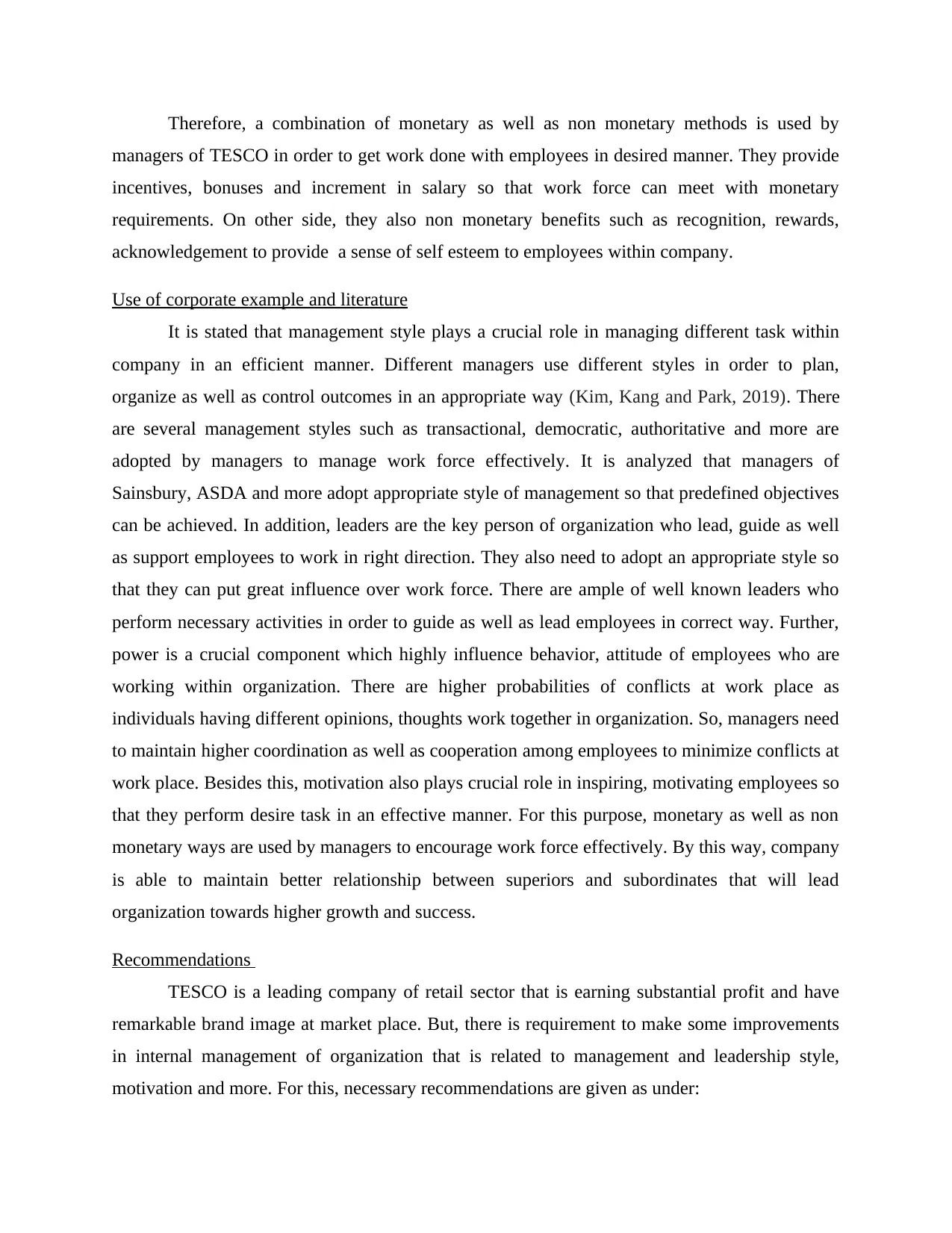
Therefore, a combination of monetary as well as non monetary methods is used by
managers of TESCO in order to get work done with employees in desired manner. They provide
incentives, bonuses and increment in salary so that work force can meet with monetary
requirements. On other side, they also non monetary benefits such as recognition, rewards,
acknowledgement to provide a sense of self esteem to employees within company.
Use of corporate example and literature
It is stated that management style plays a crucial role in managing different task within
company in an efficient manner. Different managers use different styles in order to plan,
organize as well as control outcomes in an appropriate way (Kim, Kang and Park, 2019). There
are several management styles such as transactional, democratic, authoritative and more are
adopted by managers to manage work force effectively. It is analyzed that managers of
Sainsbury, ASDA and more adopt appropriate style of management so that predefined objectives
can be achieved. In addition, leaders are the key person of organization who lead, guide as well
as support employees to work in right direction. They also need to adopt an appropriate style so
that they can put great influence over work force. There are ample of well known leaders who
perform necessary activities in order to guide as well as lead employees in correct way. Further,
power is a crucial component which highly influence behavior, attitude of employees who are
working within organization. There are higher probabilities of conflicts at work place as
individuals having different opinions, thoughts work together in organization. So, managers need
to maintain higher coordination as well as cooperation among employees to minimize conflicts at
work place. Besides this, motivation also plays crucial role in inspiring, motivating employees so
that they perform desire task in an effective manner. For this purpose, monetary as well as non
monetary ways are used by managers to encourage work force effectively. By this way, company
is able to maintain better relationship between superiors and subordinates that will lead
organization towards higher growth and success.
Recommendations
TESCO is a leading company of retail sector that is earning substantial profit and have
remarkable brand image at market place. But, there is requirement to make some improvements
in internal management of organization that is related to management and leadership style,
motivation and more. For this, necessary recommendations are given as under:
managers of TESCO in order to get work done with employees in desired manner. They provide
incentives, bonuses and increment in salary so that work force can meet with monetary
requirements. On other side, they also non monetary benefits such as recognition, rewards,
acknowledgement to provide a sense of self esteem to employees within company.
Use of corporate example and literature
It is stated that management style plays a crucial role in managing different task within
company in an efficient manner. Different managers use different styles in order to plan,
organize as well as control outcomes in an appropriate way (Kim, Kang and Park, 2019). There
are several management styles such as transactional, democratic, authoritative and more are
adopted by managers to manage work force effectively. It is analyzed that managers of
Sainsbury, ASDA and more adopt appropriate style of management so that predefined objectives
can be achieved. In addition, leaders are the key person of organization who lead, guide as well
as support employees to work in right direction. They also need to adopt an appropriate style so
that they can put great influence over work force. There are ample of well known leaders who
perform necessary activities in order to guide as well as lead employees in correct way. Further,
power is a crucial component which highly influence behavior, attitude of employees who are
working within organization. There are higher probabilities of conflicts at work place as
individuals having different opinions, thoughts work together in organization. So, managers need
to maintain higher coordination as well as cooperation among employees to minimize conflicts at
work place. Besides this, motivation also plays crucial role in inspiring, motivating employees so
that they perform desire task in an effective manner. For this purpose, monetary as well as non
monetary ways are used by managers to encourage work force effectively. By this way, company
is able to maintain better relationship between superiors and subordinates that will lead
organization towards higher growth and success.
Recommendations
TESCO is a leading company of retail sector that is earning substantial profit and have
remarkable brand image at market place. But, there is requirement to make some improvements
in internal management of organization that is related to management and leadership style,
motivation and more. For this, necessary recommendations are given as under:
⊘ This is a preview!⊘
Do you want full access?
Subscribe today to unlock all pages.

Trusted by 1+ million students worldwide
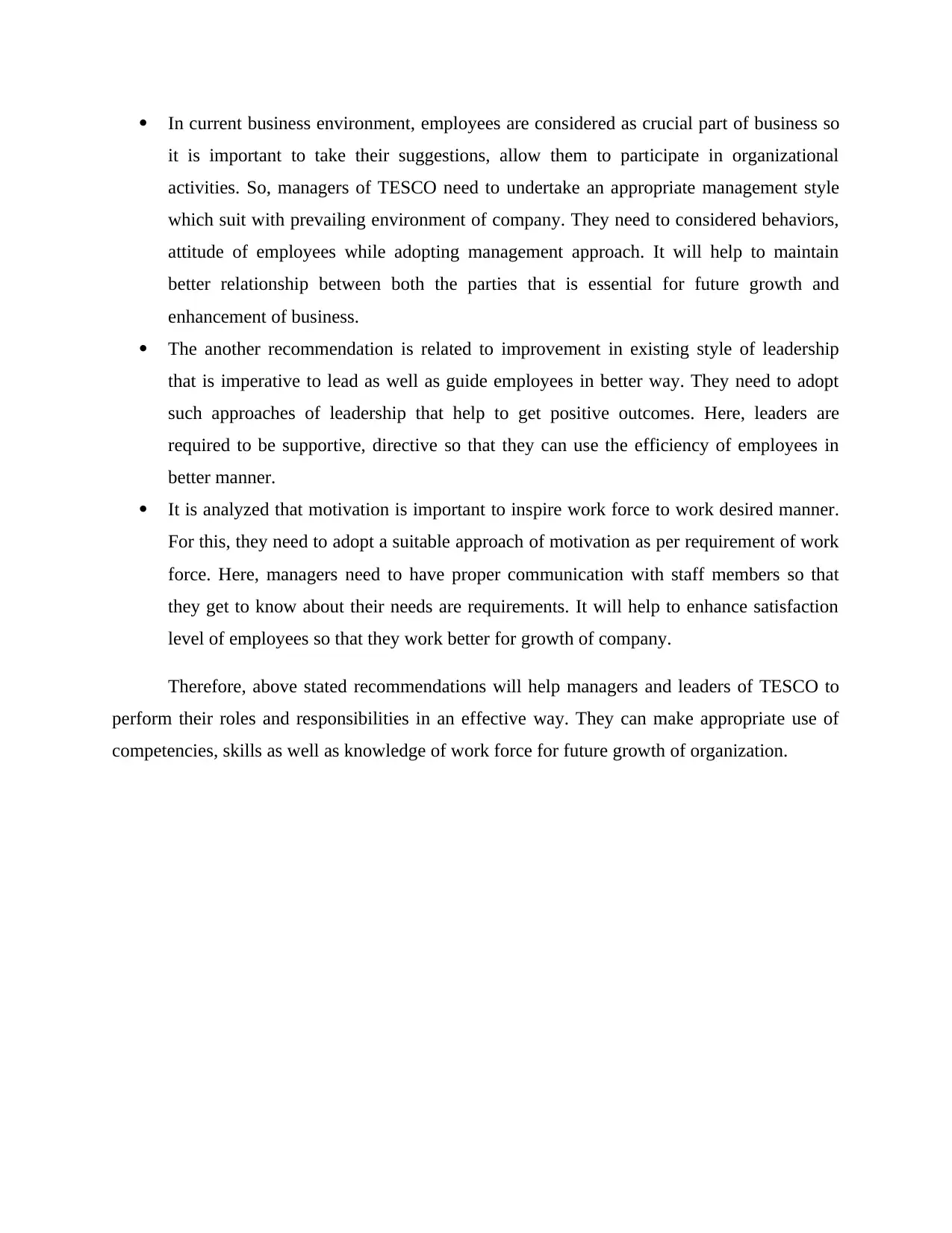
In current business environment, employees are considered as crucial part of business so
it is important to take their suggestions, allow them to participate in organizational
activities. So, managers of TESCO need to undertake an appropriate management style
which suit with prevailing environment of company. They need to considered behaviors,
attitude of employees while adopting management approach. It will help to maintain
better relationship between both the parties that is essential for future growth and
enhancement of business.
The another recommendation is related to improvement in existing style of leadership
that is imperative to lead as well as guide employees in better way. They need to adopt
such approaches of leadership that help to get positive outcomes. Here, leaders are
required to be supportive, directive so that they can use the efficiency of employees in
better manner.
It is analyzed that motivation is important to inspire work force to work desired manner.
For this, they need to adopt a suitable approach of motivation as per requirement of work
force. Here, managers need to have proper communication with staff members so that
they get to know about their needs are requirements. It will help to enhance satisfaction
level of employees so that they work better for growth of company.
Therefore, above stated recommendations will help managers and leaders of TESCO to
perform their roles and responsibilities in an effective way. They can make appropriate use of
competencies, skills as well as knowledge of work force for future growth of organization.
it is important to take their suggestions, allow them to participate in organizational
activities. So, managers of TESCO need to undertake an appropriate management style
which suit with prevailing environment of company. They need to considered behaviors,
attitude of employees while adopting management approach. It will help to maintain
better relationship between both the parties that is essential for future growth and
enhancement of business.
The another recommendation is related to improvement in existing style of leadership
that is imperative to lead as well as guide employees in better way. They need to adopt
such approaches of leadership that help to get positive outcomes. Here, leaders are
required to be supportive, directive so that they can use the efficiency of employees in
better manner.
It is analyzed that motivation is important to inspire work force to work desired manner.
For this, they need to adopt a suitable approach of motivation as per requirement of work
force. Here, managers need to have proper communication with staff members so that
they get to know about their needs are requirements. It will help to enhance satisfaction
level of employees so that they work better for growth of company.
Therefore, above stated recommendations will help managers and leaders of TESCO to
perform their roles and responsibilities in an effective way. They can make appropriate use of
competencies, skills as well as knowledge of work force for future growth of organization.
Paraphrase This Document
Need a fresh take? Get an instant paraphrase of this document with our AI Paraphraser
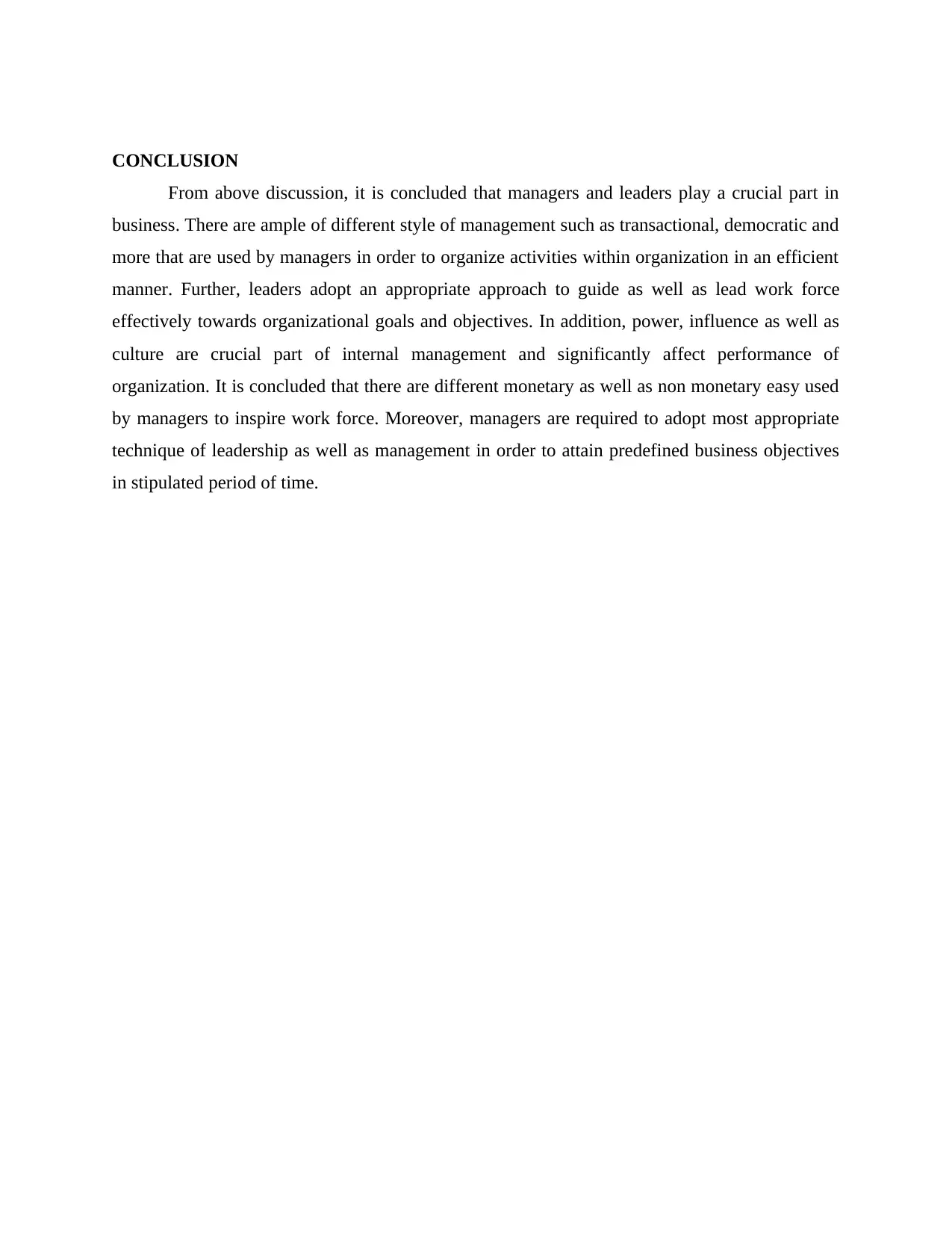
CONCLUSION
From above discussion, it is concluded that managers and leaders play a crucial part in
business. There are ample of different style of management such as transactional, democratic and
more that are used by managers in order to organize activities within organization in an efficient
manner. Further, leaders adopt an appropriate approach to guide as well as lead work force
effectively towards organizational goals and objectives. In addition, power, influence as well as
culture are crucial part of internal management and significantly affect performance of
organization. It is concluded that there are different monetary as well as non monetary easy used
by managers to inspire work force. Moreover, managers are required to adopt most appropriate
technique of leadership as well as management in order to attain predefined business objectives
in stipulated period of time.
From above discussion, it is concluded that managers and leaders play a crucial part in
business. There are ample of different style of management such as transactional, democratic and
more that are used by managers in order to organize activities within organization in an efficient
manner. Further, leaders adopt an appropriate approach to guide as well as lead work force
effectively towards organizational goals and objectives. In addition, power, influence as well as
culture are crucial part of internal management and significantly affect performance of
organization. It is concluded that there are different monetary as well as non monetary easy used
by managers to inspire work force. Moreover, managers are required to adopt most appropriate
technique of leadership as well as management in order to attain predefined business objectives
in stipulated period of time.
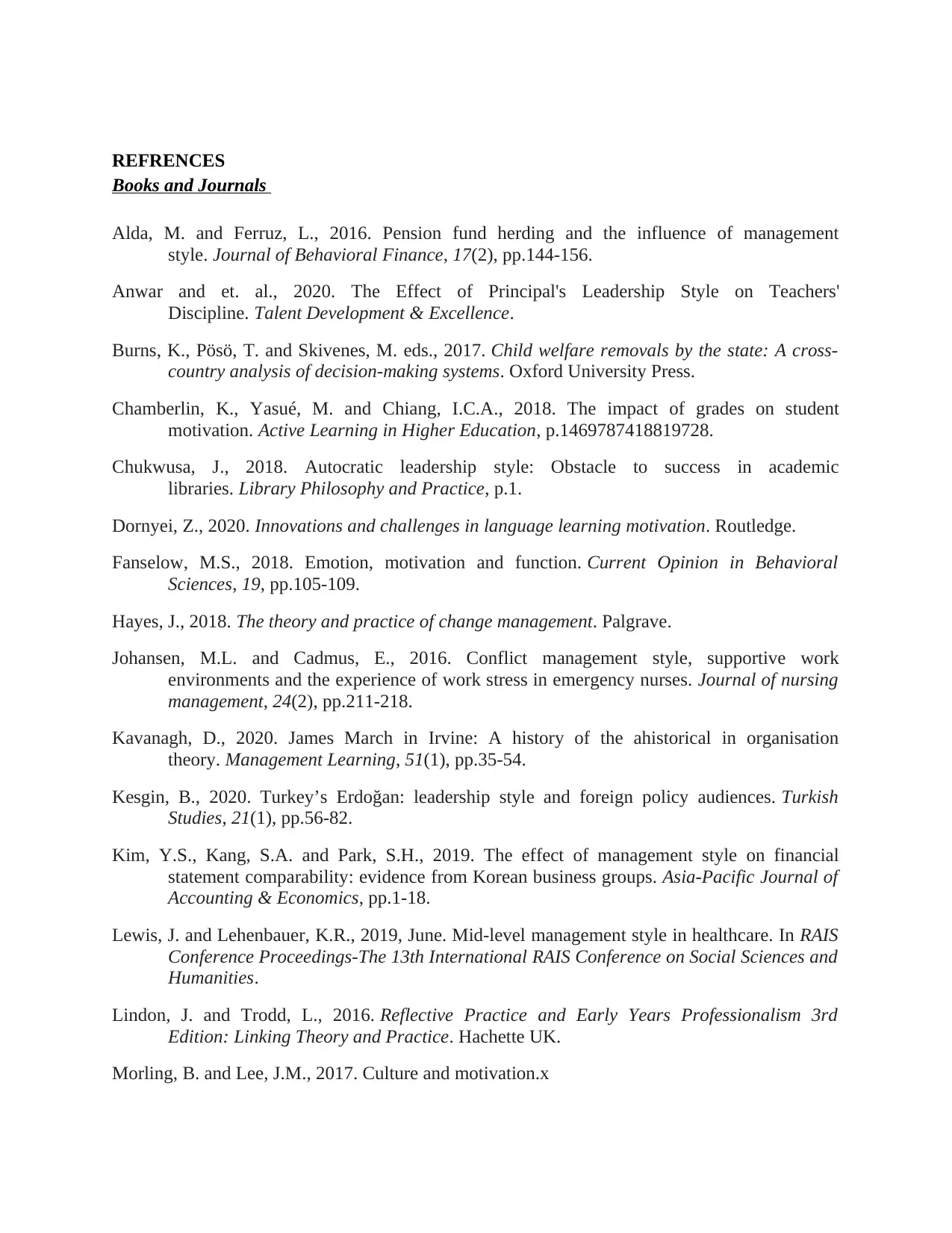
REFRENCES
Books and Journals
Alda, M. and Ferruz, L., 2016. Pension fund herding and the influence of management
style. Journal of Behavioral Finance, 17(2), pp.144-156.
Anwar and et. al., 2020. The Effect of Principal's Leadership Style on Teachers'
Discipline. Talent Development & Excellence.
Burns, K., Pösö, T. and Skivenes, M. eds., 2017. Child welfare removals by the state: A cross-
country analysis of decision-making systems. Oxford University Press.
Chamberlin, K., Yasué, M. and Chiang, I.C.A., 2018. The impact of grades on student
motivation. Active Learning in Higher Education, p.1469787418819728.
Chukwusa, J., 2018. Autocratic leadership style: Obstacle to success in academic
libraries. Library Philosophy and Practice, p.1.
Dornyei, Z., 2020. Innovations and challenges in language learning motivation. Routledge.
Fanselow, M.S., 2018. Emotion, motivation and function. Current Opinion in Behavioral
Sciences, 19, pp.105-109.
Hayes, J., 2018. The theory and practice of change management. Palgrave.
Johansen, M.L. and Cadmus, E., 2016. Conflict management style, supportive work
environments and the experience of work stress in emergency nurses. Journal of nursing
management, 24(2), pp.211-218.
Kavanagh, D., 2020. James March in Irvine: A history of the ahistorical in organisation
theory. Management Learning, 51(1), pp.35-54.
Kesgin, B., 2020. Turkey’s Erdoğan: leadership style and foreign policy audiences. Turkish
Studies, 21(1), pp.56-82.
Kim, Y.S., Kang, S.A. and Park, S.H., 2019. The effect of management style on financial
statement comparability: evidence from Korean business groups. Asia-Pacific Journal of
Accounting & Economics, pp.1-18.
Lewis, J. and Lehenbauer, K.R., 2019, June. Mid-level management style in healthcare. In RAIS
Conference Proceedings-The 13th International RAIS Conference on Social Sciences and
Humanities.
Lindon, J. and Trodd, L., 2016. Reflective Practice and Early Years Professionalism 3rd
Edition: Linking Theory and Practice. Hachette UK.
Morling, B. and Lee, J.M., 2017. Culture and motivation.x
Books and Journals
Alda, M. and Ferruz, L., 2016. Pension fund herding and the influence of management
style. Journal of Behavioral Finance, 17(2), pp.144-156.
Anwar and et. al., 2020. The Effect of Principal's Leadership Style on Teachers'
Discipline. Talent Development & Excellence.
Burns, K., Pösö, T. and Skivenes, M. eds., 2017. Child welfare removals by the state: A cross-
country analysis of decision-making systems. Oxford University Press.
Chamberlin, K., Yasué, M. and Chiang, I.C.A., 2018. The impact of grades on student
motivation. Active Learning in Higher Education, p.1469787418819728.
Chukwusa, J., 2018. Autocratic leadership style: Obstacle to success in academic
libraries. Library Philosophy and Practice, p.1.
Dornyei, Z., 2020. Innovations and challenges in language learning motivation. Routledge.
Fanselow, M.S., 2018. Emotion, motivation and function. Current Opinion in Behavioral
Sciences, 19, pp.105-109.
Hayes, J., 2018. The theory and practice of change management. Palgrave.
Johansen, M.L. and Cadmus, E., 2016. Conflict management style, supportive work
environments and the experience of work stress in emergency nurses. Journal of nursing
management, 24(2), pp.211-218.
Kavanagh, D., 2020. James March in Irvine: A history of the ahistorical in organisation
theory. Management Learning, 51(1), pp.35-54.
Kesgin, B., 2020. Turkey’s Erdoğan: leadership style and foreign policy audiences. Turkish
Studies, 21(1), pp.56-82.
Kim, Y.S., Kang, S.A. and Park, S.H., 2019. The effect of management style on financial
statement comparability: evidence from Korean business groups. Asia-Pacific Journal of
Accounting & Economics, pp.1-18.
Lewis, J. and Lehenbauer, K.R., 2019, June. Mid-level management style in healthcare. In RAIS
Conference Proceedings-The 13th International RAIS Conference on Social Sciences and
Humanities.
Lindon, J. and Trodd, L., 2016. Reflective Practice and Early Years Professionalism 3rd
Edition: Linking Theory and Practice. Hachette UK.
Morling, B. and Lee, J.M., 2017. Culture and motivation.x
⊘ This is a preview!⊘
Do you want full access?
Subscribe today to unlock all pages.

Trusted by 1+ million students worldwide
1 out of 13
Related Documents
Your All-in-One AI-Powered Toolkit for Academic Success.
+13062052269
info@desklib.com
Available 24*7 on WhatsApp / Email
![[object Object]](/_next/static/media/star-bottom.7253800d.svg)
Unlock your academic potential
Copyright © 2020–2025 A2Z Services. All Rights Reserved. Developed and managed by ZUCOL.





